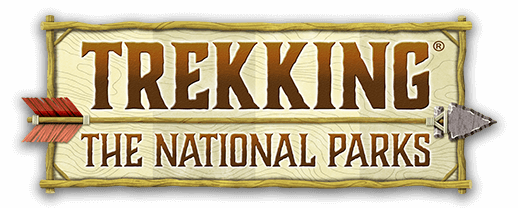Petrified Forest National Park
Located: Arizona - Established: December 9, 1962
The Park: Like North Cascades, Petrified Forest National Park is divided into two sections. The Painted Desert – a landscape consisting of colorful layers of intriguing landforms, lies north of I-40. South of I-40 is where you’ll find a treasure trove of petrified trees scattered across the barren desert floor.
Once a land filled with tall conifers, floods felled the trees 225 million years ago and buried them in a mix of silt, mud and volcanic ash. The sediment cut off oxygen, which slowed the decay of the trees. The sediment seeped into the fallen logs replacing the original wood tissue with silica deposits. The silica crystalized into quartz, thus petrifying the trees! Over time, the continents shifted and the subsequent uplifting combined with the erosive properties of wind, rain, and water eventually exposed these fossilized trees.
Well preserved petrified log
Among the most fascinating aspects of Petrified are the park’s petroglyphs. Petroglyphs are rock drawings created by Native Americans who chiseled through the dark patina, known as desert varnish that covers the surface of sandstone. Beneath the varnish, the rock is much lighter in color, so the “rock art” usually stands out clearly once the surface layer has been removed.
The meaning of the “rock art” is speculative; however, much of the work seems to be inspired by nature. Many petroglyphs depict solar calendars while others resemble human and animal figures, geometric shapes and unidentifiable rock doodles!
Getting there: Petrified is located 115 miles east of Flagstaff, AZ just off Interstate 40. From Phoenix, the park is 211 miles to the northeast via SR-87/260.
Local resident of the Petrified Forest
When to visit: The park is open year round. Summer is the busiest (and warmest), winter the slowest. With spring come the wildflowers as well as the wind. Fall is an excellent time to visit.
What to do: Start your visit at the Painted Desert Visitor Center on the north side of I-40 (Exit 311). Take the short scenic drive the Painted Desert section of the park and stop at the various viewpoints for panoramic views of this colorful desertscape.
The Tepees
Once you head south of I-40, stop off at the archeological site Puerco Pueblo. Next up will be Newspaper Rock– 650 petroglyphs etched into the boulders. The Tepees are conical shaped mounds with layers of blues, purples and grays. Blue Mesa and Blue Mesa Trail will give you the experience of hiking in a “badlands” environment. One of the largest collections of petrified wood can be found Jasper Forest. The Giant Logs Trail takes you to the largest petrified log in the park – “Old Faithful!”
Day Hiking. The best way to experience Petrified is to hike amongst the ancient forests. Several maintained trails and some suggested “routes” have been established to allow you to get to know the park more intimately.
Where to stay:There are no lodges or designated campgrounds within the park; however, backcountry camping is allowed. Most backpackers hike into the Painted Desert Wilderness Area. Hotels can be found in town of Holbrook 26-miles west of the park.
Random logs
Challenge: Perhaps the major challenge faced by this park is theft of the petrified wood, which is easily accessible to all park visitors. It is against the law and against good ethical practice to steal the petrified wood! If you visit this unique park, lease DO NOT remove the petrified wood! However, do enjoy this unique experience!
Trivia: Petrified wood in this Forest is almost solid quartz, weighing in at 168 pounds per cubic foot. It's so hard, it can only be cut with a diamond tipped saw!
Banner: The Painted Desert north of I-40.
Experience these Check List:
- Stop by the park's Painted Desert Visitor Center
- Visit the Rainbow Forest Museum
- Investigate Puerco Pueblo
- Discover Newspaper Rock
- Observe the colorful Tepees
- Enjoy the Giant Logs
- Do not take the petrified wood home!





